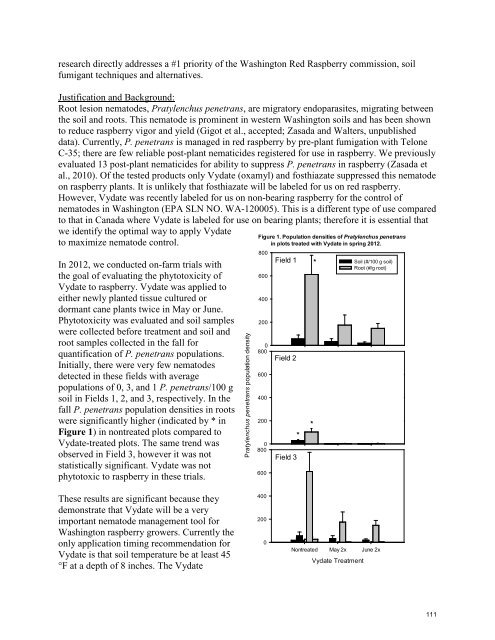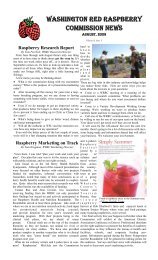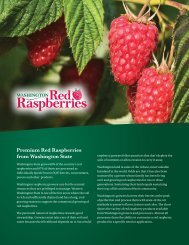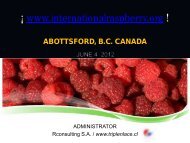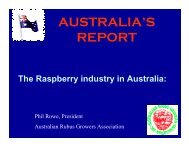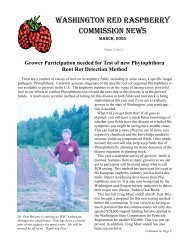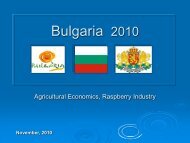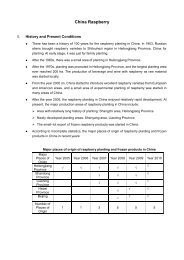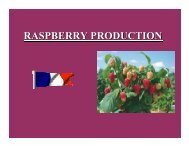2012 - Washington Red Raspberry Commission
2012 - Washington Red Raspberry Commission
2012 - Washington Red Raspberry Commission
You also want an ePaper? Increase the reach of your titles
YUMPU automatically turns print PDFs into web optimized ePapers that Google loves.
esearch directly addresses a #1 priority of the <strong>Washington</strong> <strong>Red</strong> <strong>Raspberry</strong> commission, soil<br />
fumigant techniques and alternatives.<br />
Justification and Background:<br />
Root lesion nematodes, Pratylenchus penetrans, are migratory endoparasites, migrating between<br />
the soil and roots. This nematode is prominent in western <strong>Washington</strong> soils and has been shown<br />
to reduce raspberry vigor and yield (Gigot et al., accepted; Zasada and Walters, unpublished<br />
data). Currently, P. penetrans is managed in red raspberry by pre-plant fumigation with Telone<br />
C-35; there are few reliable post-plant nematicides registered for use in raspberry. We previously<br />
evaluated 13 post-plant nematicides for ability to suppress P. penetrans in raspberry (Zasada et<br />
al., 2010). Of the tested products only Vydate (oxamyl) and fosthiazate suppressed this nematode<br />
on raspberry plants. It is unlikely that fosthiazate will be labeled for us on red raspberry.<br />
However, Vydate was recently labeled for us on non-bearing raspberry for the control of<br />
nematodes in <strong>Washington</strong> (EPA SLN NO. WA-120005). This is a different type of use compared<br />
to that in Canada where Vydate is labeled for use on bearing plants; therefore it is essential that<br />
we identify the optimal way to apply Vydate<br />
Figure 1. Population densities of Pratylenchus penetrans<br />
to maximize nematode control.<br />
in plots treated with Vydate in spring <strong>2012</strong>.<br />
In <strong>2012</strong>, we conducted on-farm trials with<br />
the goal of evaluating the phytotoxicity of<br />
Vydate to raspberry. Vydate was applied to<br />
either newly planted tissue cultured or<br />
dormant cane plants twice in May or June.<br />
Phytotoxicity was evaluated and soil samples<br />
were collected before treatment and soil and<br />
root samples collected in the fall for<br />
quantification of P. penetrans populations.<br />
Initially, there were very few nematodes<br />
detected in these fields with average<br />
populations of 0, 3, and 1 P. penetrans/100 g<br />
soil in Fields 1, 2, and 3, respectively. In the<br />
fall P. penetrans population densities in roots<br />
were significantly higher (indicated by * in<br />
Figure 1) in nontreated plots compared to<br />
Vydate-treated plots. The same trend was<br />
observed in Field 3, however it was not<br />
statistically significant. Vydate was not<br />
phytotoxic to raspberry in these trials.<br />
Pratylenchus penetrans population density<br />
800<br />
600<br />
400<br />
200<br />
0<br />
800<br />
600<br />
400<br />
200<br />
0<br />
800<br />
600<br />
Field 1<br />
Field 2<br />
Field 3<br />
*<br />
*<br />
*<br />
Soil (#/100 g soil)<br />
Root (#/g root)<br />
These results are significant because they<br />
demonstrate that Vydate will be a very<br />
important nematode management tool for<br />
<strong>Washington</strong> raspberry growers. Currently the<br />
only application timing recommendation for<br />
Vydate is that soil temperature be at least 45<br />
°F at a depth of 8 inches. The Vydate<br />
400<br />
200<br />
0<br />
Nontreated May 2x June 2x<br />
Vydate Treatment<br />
111


